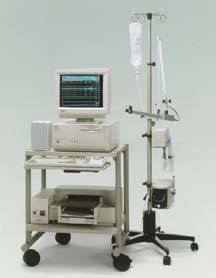Urodynamics
Urodynamic Assessment is a highly specialised and sophisticated method of making a scientifically accurate diagnosis of the cause of incontinence. The Urodynamic recording system, which measures all the important functions of the bladder, is connected to a computer. This is used to measure, integrate and correlate urine flow rate, bladder capacity, and muscular and nervous control. This assessment is relatively inexpensive, takes approximately 45 minutes, does not require the use of drugs and is painless.
Procedure
Small-sized catheters are inserted into the urinary bladder, urethra, and rectum. Fluid is filled in the bladder and pressures are monitored to examine the lower urinary function. The tubes are connected to machines and a computer calculates various pressures and guides about disease entities.

Urodynamic computer
It is not advisable to take the test if there any urinary infection.
The principle investigations are
|
Investigation |
Symptoms |
Possible diagnosis |
|
Uroflow |
Frequency, nocturia, poor flow |
Bladder outlet obstruction |
|
Pressure flow |
Frequency, nocturia, poor flow |
Bladder outlet obstruction |
|
Cystometry |
Frequency, urgency |
Detrusor instability |
|
Urethral closure pressure |
Incontinence |
Genuine stress incontinence |
|
Ambulatory urodynamics |
Frequency, urgency pointing to unstable bladder but not shown on staticurodynamics |
Detrusor instability, Genuine stress incontinence |
What if Abnormalities are Detected?
Urodynamic Assessment accurately detects most abnormalities. Depending on the diagnosis, the treatment recommended may include the taking of certain drugs, special pelvic floor exercises, physiotherapy or possible surgery.
How Often is Urodynamic Assessment Necessary?
In most cases a single visit is all that is required. With the extremely accurate diagnosis and the provision of recommended treatment, most people should find that their problems, if not totally solved, are markedly improved.
How I Arrange for a Urodynamic Assessment?
You can arrange an appointment for Urodynamic Assessment through your General Practitioner or, if you are under the treatment of a Gynaecologist or Urologist, they can organise the tests for you. As some women experience a certain degree of discomfort with their periods, it is advisable not to attend during menstruation.
Points of Interest
- The procedure is mostly performed as an outpatient test. You will have to give a urine sample prior to your test
- You must sign an informed consent
- Make sure that there is no urinary infection. If UTI is detected on an urinary examination, the procedure is postponed and appropriate antibiotics are given
- It usually takes 30 to 45 minutes for the procedure
- Patient empties the bladder prior to the procedure
- Patients are usually given 6 dosages of antibiotics








